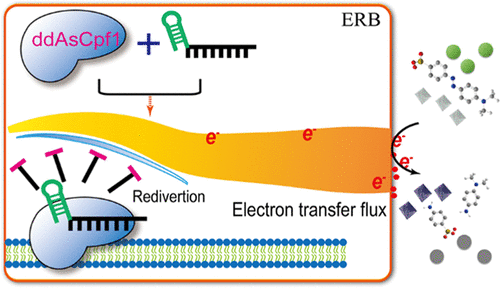当前位置:
X-MOL 学术
›
Environ. Sci. Technol.
›
论文详情
Our official English website, www.x-mol.net, welcomes your feedback! (Note: you will need to create a separate account there.)
Rediverting Electron Flux with an Engineered CRISPR-ddAsCpf1 System to Enhance the Pollutant Degradation Capacity of Shewanella oneidensis.
Environmental Science & Technology ( IF 11.4 ) Pub Date : 2020-02-16 , DOI: 10.1021/acs.est.9b06378 Jie Li 1, 2, 3 , Qiang Tang 1 , Yang Li 1 , Yang-Yang Fan 1 , Feng-He Li 1 , Jing-Hang Wu 1 , Di Min 1 , Wen-Wei Li 1, 2 , Paul K S Lam 2, 3 , Han-Qing Yu 1, 2
Environmental Science & Technology ( IF 11.4 ) Pub Date : 2020-02-16 , DOI: 10.1021/acs.est.9b06378 Jie Li 1, 2, 3 , Qiang Tang 1 , Yang Li 1 , Yang-Yang Fan 1 , Feng-He Li 1 , Jing-Hang Wu 1 , Di Min 1 , Wen-Wei Li 1, 2 , Paul K S Lam 2, 3 , Han-Qing Yu 1, 2
Affiliation

|
Pursuing efficient approaches to promote the extracellular electron transfer (EET) of extracellular respiratory bacteria is essential to their application in environmental remediation and waste treatment. Here, we report a new strategy of tuning electron flux by clustered regularly interspaced short palindromic repeat (CRISPR)-ddAsCpf1-based rediverting (namely STAR) to enhance the EET capacity of Shewanella oneidensis MR-1, a model extracellular respiratory bacterium widely present in the environment. The developed CRISPR-ddAsCpf1 system enabled approximately 100% gene repression with the green fluorescent protein (GFP) as a reporter. Using a WO3 probe, 10 representative genes encoding for putative competitive electron transfer proteins were screened, among which 7 genes were identified as valid targets for EET enhancement. Repressing the valid genes not only increased the transcription level of the l-lactate metabolism genes but also affected the genes involved in direct and indirect EET. Increased riboflavin production was also observed. The feasibility of this strategy to enhance the bioreduction of methyl orange, an organic pollutant, and chromium, a typical heavy metal, was demonstrated. This work implies a great potential of the STAR strategy with the CIRPSR-ddAsCpf1 system for enhancing bacterial EET to favor more efficient environmental remediation applications.
中文翻译:

用工程CRISPR-ddAsCpf1系统重新分配电子通量以增强Shewanella oneidensis的污染物降解能力。
寻求有效的方法来促进细胞外呼吸细菌的细胞外电子转移(EET),对于它们在环境修复和废物处理中的应用至关重要。在这里,我们报告了一种通过簇状规则间隔的短回文重复序列(CRISPR)-ddAsCpf1的改向(即STAR)来调节电子通量的新策略,以增强Shewanella oneidensis MR-1的EET能力,Shewanella oneidensis MR-1是一种广泛存在于该模型中的细胞外呼吸细菌。环境。开发的CRISPR-ddAsCpf1系统以绿色荧光蛋白(GFP)为报告基因,可实现约100%的基因抑制。使用WO3探针,筛选了10个编码假定的竞争性电子转移蛋白的代表性基因,其中7个基因被确定为EET增强的有效靶标。抑制有效基因不仅增加了l-乳酸代谢基因的转录水平,而且影响了直接和间接EET中涉及的基因。还观察到核黄素产量增加。证明了该策略可增强有机污染物甲基橙和典型重金属铬的生物还原的可行性。这项工作意味着采用CIRPSR-ddAsCpf1系统的STAR策略在增强细菌EET以支持更有效的环境修复应用方面具有巨大潜力。并展示了一种典型的重金属铬。这项工作意味着采用CIRPSR-ddAsCpf1系统的STAR策略在增强细菌EET以支持更有效的环境修复应用方面具有巨大潜力。并展示了一种典型的重金属铬。这项工作意味着采用CIRPSR-ddAsCpf1系统的STAR策略在增强细菌EET以支持更有效的环境修复应用方面具有巨大潜力。
更新日期:2020-02-27
中文翻译:

用工程CRISPR-ddAsCpf1系统重新分配电子通量以增强Shewanella oneidensis的污染物降解能力。
寻求有效的方法来促进细胞外呼吸细菌的细胞外电子转移(EET),对于它们在环境修复和废物处理中的应用至关重要。在这里,我们报告了一种通过簇状规则间隔的短回文重复序列(CRISPR)-ddAsCpf1的改向(即STAR)来调节电子通量的新策略,以增强Shewanella oneidensis MR-1的EET能力,Shewanella oneidensis MR-1是一种广泛存在于该模型中的细胞外呼吸细菌。环境。开发的CRISPR-ddAsCpf1系统以绿色荧光蛋白(GFP)为报告基因,可实现约100%的基因抑制。使用WO3探针,筛选了10个编码假定的竞争性电子转移蛋白的代表性基因,其中7个基因被确定为EET增强的有效靶标。抑制有效基因不仅增加了l-乳酸代谢基因的转录水平,而且影响了直接和间接EET中涉及的基因。还观察到核黄素产量增加。证明了该策略可增强有机污染物甲基橙和典型重金属铬的生物还原的可行性。这项工作意味着采用CIRPSR-ddAsCpf1系统的STAR策略在增强细菌EET以支持更有效的环境修复应用方面具有巨大潜力。并展示了一种典型的重金属铬。这项工作意味着采用CIRPSR-ddAsCpf1系统的STAR策略在增强细菌EET以支持更有效的环境修复应用方面具有巨大潜力。并展示了一种典型的重金属铬。这项工作意味着采用CIRPSR-ddAsCpf1系统的STAR策略在增强细菌EET以支持更有效的环境修复应用方面具有巨大潜力。



























 京公网安备 11010802027423号
京公网安备 11010802027423号